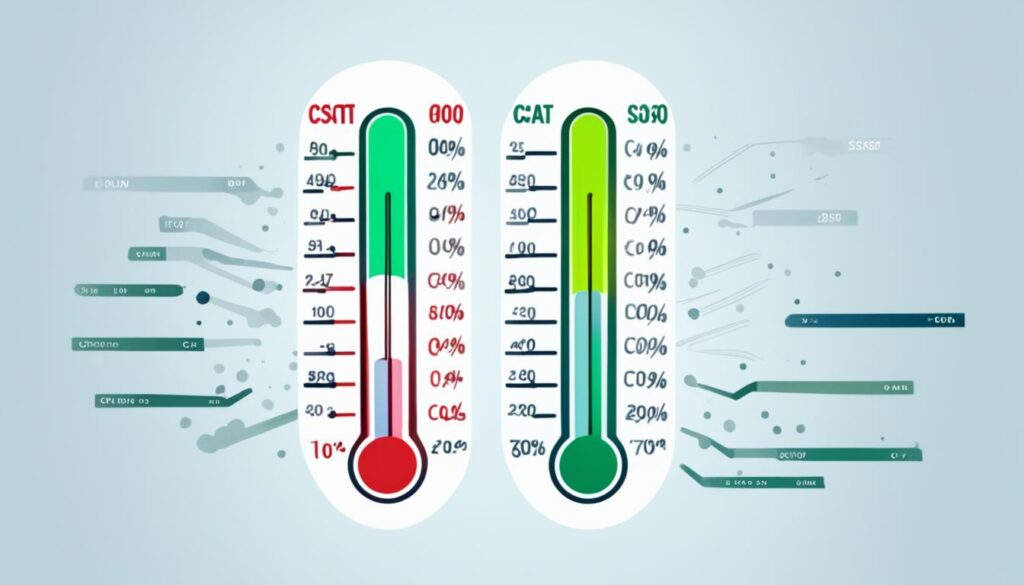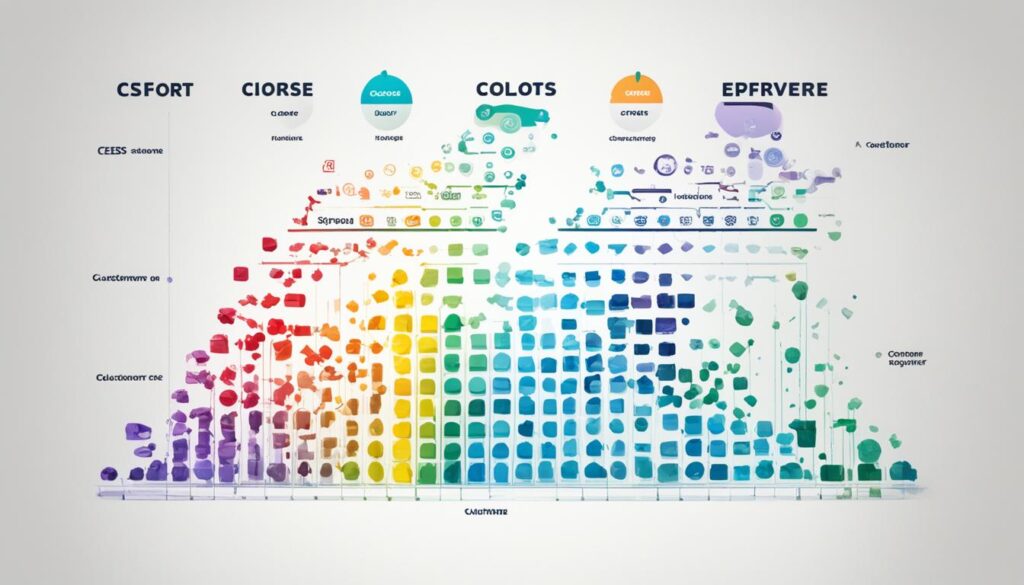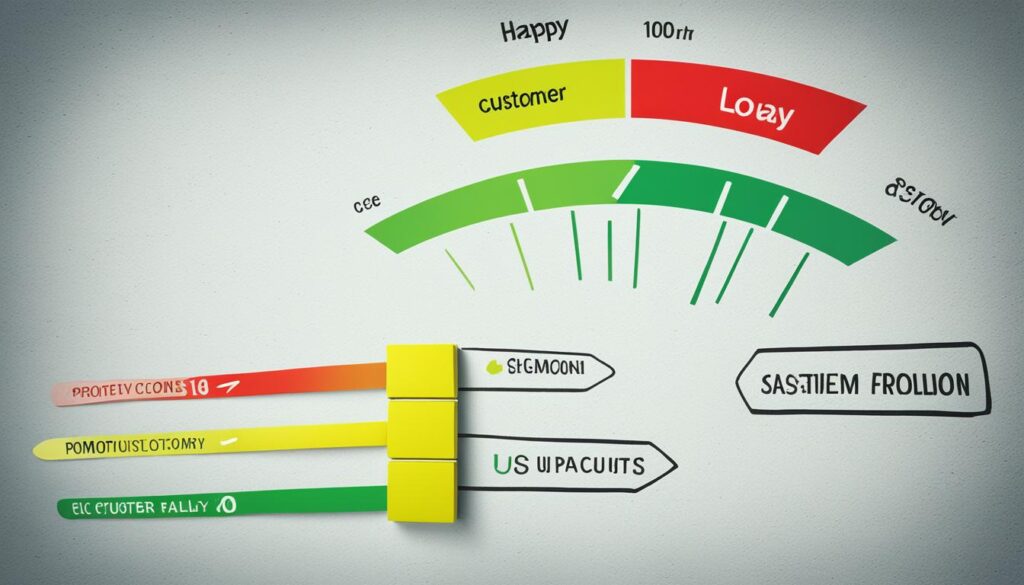Measuring customer service is crucial for businesses looking to improve customer loyalty and overall performance. By tracking customer service metrics, you can evaluate the effectiveness of your customer support and make data-driven improvements. In this article, we will explore key customer service metrics, such as customer satisfaction score (CSAT), customer effort score (CES), net promoter score (NPS), social media metrics, and churn metrics, that can help you assess and enhance your customer service performance.
Key Takeaways:
- Measuring customer service is essential for improving customer loyalty and performance.
- Customer service metrics provide insights into customer satisfaction, effort, and loyalty.
- CSAT score measures customer satisfaction with a recent support experience.
- CES measures the ease of customer interaction and task resolution.
- NPS measures customer loyalty and the likelihood of recommendations.
- Tracking social media metrics helps analyze customer feedback and public perception.
- Churn metrics measure customer cancellations and provide insights for retention.
Customer Satisfaction (CSAT) Score
In order to gauge the level of customer satisfaction with your support services, it is important to measure the Customer Satisfaction (CSAT) score. This metric provides valuable insights into the overall customer experience and can help you identify areas for improvement.
The CSAT score is typically collected through customer satisfaction surveys, which ask customers to rate their recent support experience on a scale or as “good” or “bad.” These surveys can also include open-ended questions to gather additional feedback and context.
By utilizing customer satisfaction surveys and measuring the CSAT score, you can evaluate the effectiveness of your support team and identify areas where improvements are needed. This key performance indicator (KPI) allows you to monitor and track changes in customer satisfaction over time, providing valuable data for making informed decisions and implementing impactful changes.
Benefits of measuring CSAT score:
- Identify areas for improvement in your support services.
- Gain insights into the effectiveness of your support team.
- Track changes in customer satisfaction over time.
- Make data-driven decisions to enhance the customer experience.

| CSAT Score | Description |
|---|---|
| 1-2 | Highly dissatisfied |
| 3-4 | Dissatisfied |
| 5 | Neutral |
| 6-7 | Satisfied |
| 8-9 | Highly satisfied |
| 10 | Extremely satisfied |
Customer Effort Score (CES)
The Customer Effort Score (CES) is a valuable metric in measuring customer effort and evaluating the ease of customer interactions. By collecting feedback through surveys, businesses can assess the level of effort customers experience when resolving issues or completing tasks. The CES utilizes a rating system where customers indicate the ease of their interaction, with lower scores indicating higher customer effort and higher scores indicating lower customer effort.
Measuring CES provides valuable insights for businesses to identify areas where they can enhance the customer experience and make interactions more seamless and effortless. By analyzing CES data, companies can identify pain points and implement strategies to reduce customer effort. Improving the ease of customer interactions can boost customer satisfaction, loyalty, and retention.
To calculate CES, businesses administer surveys that prompt customers to rate the ease of their experience on a scale or numerical rating. An example question could be: “On a scale of 1 to 5, how easy was it for you to resolve your issue?” Open-ended questions can also provide additional qualitative feedback.
Implementing CES as part of customer service evaluations allows businesses to focus on enhancing the customer journey and optimizing processes to reduce customer effort. It complements other customer satisfaction metrics, such as CSAT and NPS, providing a more comprehensive understanding of the customer experience.

To illustrate the significance of CES, let’s consider a hypothetical scenario where a company receives high CSAT scores but consistently low CES scores. This indicates that while customers may be satisfied with the outcome, they find the process cumbersome and require significant effort to reach a resolution. By addressing the factors contributing to high customer effort, such as complex navigation, long wait times, or confusing instructions, businesses can streamline their processes and make interactions more efficient.
Net Promoter Score (NPS)
The Net Promoter Score (NPS) is a powerful metric for measuring customer loyalty and satisfaction. It provides valuable insights into how likely your customers are to recommend your business to others, making it a key indicator of customer advocacy.
To determine the NPS, you ask your customers one simple question: “On a scale of 0-10, how likely are you to recommend our company/product/service to a friend or colleague?” Based on their responses, customers are categorized into three groups:
- Promoters (score 9-10) – These are highly satisfied customers who are likely to promote your brand and become loyal advocates.
- Passives (score 7-8) – These customers are satisfied but not as enthusiastic as promoters. They might recommend your business if asked but are less likely to actively refer others.
- Detractors (score 0-6) – These are dissatisfied customers who may spread negative word-of-mouth and potentially harm your reputation.
Calculating your NPS involves subtracting the percentage of detractors from the percentage of promoters. The resulting score can range from -100 to +100.
Why is NPS important?
NPS provides a valuable measure of customer satisfaction and loyalty, enabling you to identify strengths and weaknesses in your customer experience. By tracking changes in your NPS over time, you can gauge the impact of your efforts to improve customer satisfaction and measure the effectiveness of your strategies.
Additionally, NPS can help you:
- Identify areas where you can enhance the customer experience.
- Measure the success of customer loyalty initiatives.
- Benchmark your performance against industry competitors.
- Make data-driven decisions to improve customer satisfaction and drive business growth.
Here’s an example of a Net Promoter Score calculation:
| Promoters (number of respondents) | Passives (number of respondents) | Detractors (number of respondents) | Total Respondents |
|---|---|---|---|
| 200 | 100 | 50 | 350 |
In this example, you have 200 promoters, 100 passives, and 50 detractors out of a total of 350 respondents.
Calculating the percentages:
| Promoters (%) | Passives (%) | Detractors (%) |
|---|---|---|
| (200 / 350) * 100 = 57% | (100 / 350) * 100 = 29% | (50 / 350) * 100 = 14% |
Subtracting the percentage of detractors from the percentage of promoters:
(57 – 14) = 43, resulting in an NPS score of 43.
An NPS score above 0 is considered positive, while scores above 50 are excellent. Negative scores indicate areas for improvement.

| Net Promoter Score (NPS) | Interpretation |
|---|---|
| NPS Score < 0 | Needs improvement; many detractors |
| 0 < NPS Score < 50 | Good; a healthy balance of promoters and detractors |
| NPS Score > 50 | Excellent; high number of promoters |
Social Media Metrics
Social media plays a significant role in shaping public perception and providing valuable insights for businesses. Tracking social media feedback and analyzing customer feedback on social media platforms such as Twitter, Facebook, and Instagram is essential for understanding your brand’s visibility and reputation. By monitoring social media mentions, you can gauge the sentiment surrounding your brand and identify areas of improvement or opportunities for engagement.
Tools like social media monitoring tools can automate the collection and analysis of social media feedback, saving you valuable time and effort. These tools allow you to track keywords related to your brand, industry, or products, ensuring that no valuable feedback goes unnoticed. By staying attuned to social media conversations, you can detect customer pain points, address concerns promptly, and even turn dissatisfied customers into brand advocates.
Benefits of Tracking Social Media Feedback
- Monitor and respond to customer feedback in real-time.
- Identify emerging trends and customer preferences.
- Anticipate and address potential PR crises.
- Engage with customers directly to build relationships and brand loyalty.
- Identify influencers and brand advocates for collaboration opportunities.
By leveraging social media metrics, you can harness the power of social media to enhance your customer service and improve overall customer satisfaction. Let’s take a closer look at some of the key social media metrics you should track:
| Metric | Description | Benefits |
|---|---|---|
| Social Media Mentions | The number of times your brand is mentioned on social media. | – Assess brand visibility and reach – Identify potential influencers or brand advocates |
| Sentiment Analysis | Determines the sentiment (positive, negative, neutral) associated with social media mentions. | – Understand public perception of your brand – Address negative sentiment promptly |
| Engagement Rate | Showcases the level of interaction and engagement your brand receives on social media. | – Measure the effectiveness of your social media strategy – Identify content that resonates with your audience |
![]()
Churn Metrics
Churn metrics are an essential tool for businesses to track customer churn, which measures the rate at which customers cancel their accounts or stop using a service. In order to gain valuable insights into why customers churn, collecting customer feedback on cancellations is crucial. By analyzing churn metrics and customer feedback, businesses can identify patterns and take proactive steps to retain customers.
Tracking customer churn allows businesses to evaluate the effectiveness of their strategies and make data-driven decisions to improve customer satisfaction. By understanding why customers cancel their accounts, businesses can address the underlying issues and implement necessary improvements to enhance customer retention rates.
Collecting customer feedback on cancellations provides valuable insights into customer experiences and pain points that may be driving churn. This feedback can be utilized to drive operational changes, enhance product or service offerings, and provide better support to customers in order to prevent future cancellations.
FAQ
How can customer service be measured?
Customer service can be measured through various metrics such as CSAT score, CES, NPS, social media mentions, churn metrics, first reply time, ticket reopens, resolution time, agent touches, and tickets solved. These metrics provide insights into the quality of customer service and help businesses identify areas for improvement.
What is a CSAT score?
The CSAT score is a metric that measures customer satisfaction with a recent support experience. It is collected through customer satisfaction surveys that ask customers to rate their experience on a scale or as “good” or “bad.” The CSAT score helps businesses identify areas of improvement and areas where the support team is doing well.
How is the Customer Effort Score (CES) measured?
The Customer Effort Score (CES) measures how easy it is for customers to resolve their issues or complete tasks. It is collected through surveys that ask customers to rate the ease of their interaction. A lower score indicates higher customer effort, while a higher score indicates lower customer effort. Measuring CES helps businesses identify areas where they can make the customer experience more seamless and effortless.
What is the Net Promoter Score (NPS)?
The Net Promoter Score (NPS) measures customer loyalty and satisfaction. It is collected by asking customers how likely they are to recommend the business to others on a scale of 1 to 10. The NPS categorizes customers into promoters, passives, and detractors, helping businesses assess customer loyalty and identify areas for improvement.
How can social media metrics help measure customer service?
Social media metrics involve tracking positive and negative mentions of the business on platforms like Twitter, Facebook, and Instagram. Analyzing customer feedback on social media helps businesses understand public perception and identify areas of improvement or opportunities for engagement. Social media monitoring tools can automate the collection and analysis of social media feedback.
What do churn metrics measure?
Churn metrics measure the rate at which customers cancel their accounts or stop using a service. Businesses can collect customer feedback on cancellations to understand the reasons behind customer churn. Analyzing churn metrics and customer feedback helps businesses identify patterns and make improvements to retain customers. By addressing the issues that lead to cancellations, businesses can improve customer retention and satisfaction.
